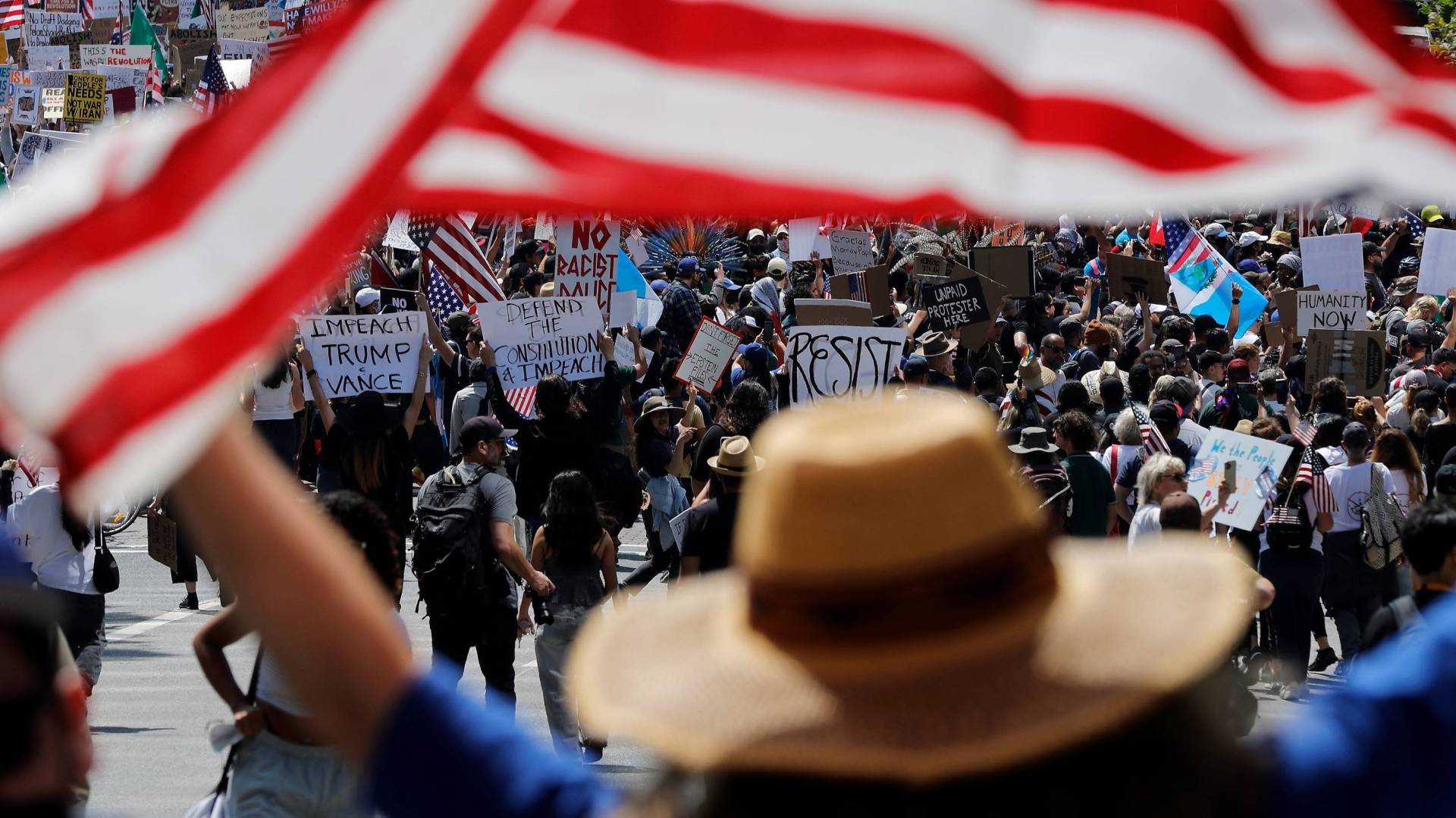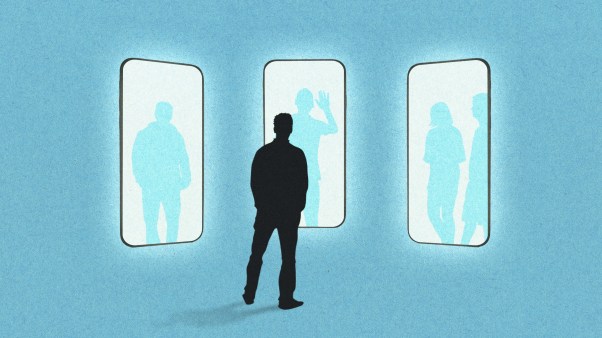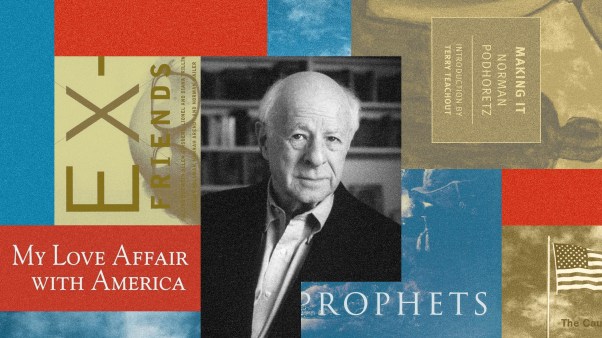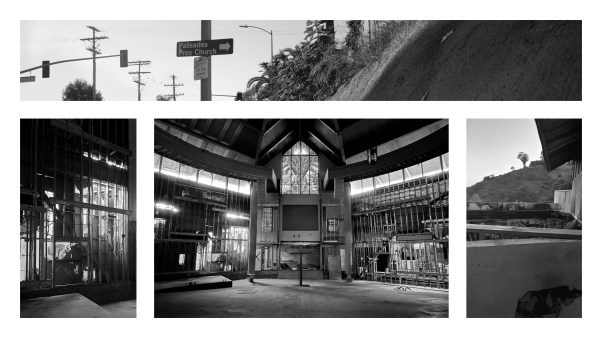After massive turnouts last weekend for “No Kings” democracy protests, activists opposed to President Donald Trump are already planning their next event: a July 17 demonstration in honor of the late Civil Rights leader and congressman John Lewis. July 17 is the date he passed in 2020.
“‘Where do we go from here?’ is a famous line from a Dr. King speech,” Barbara Arnwine with the group Transformative Justice Coalition said on a Monday-night call. “And where we go from here is July the 17th. … We’re going to make good trouble, because good trouble lives on, and we will not stop until we win: no kings, no tyrants, no despots.”
Meanwhile, a White House spokesman called the No Kings protests, which coincided with the White House’s military parade in Washington, “a complete and utter failure with minuscule attendance.”
The group of organizations that form the No Kings coalition said the events featured more than 5 million participants, and the organizers called it a “national act of joyful resistance.”
At one demonstration in Annapolis, Maryland, on Saturday, a reenactor decked out in Revolutionary War–era garb, white wig and all, stood to give a speech to a crowd of hundreds of protesters. The speech he gave is one recorded in countless US history books: George Washington’s 1783 speech relinquishing his military command.
Meanwhile, just under an hour’s drive away on the National Mall, a very different commander in chief was presiding over the first military parade in the nation’s capital since 1991.
Trump’s massive military parade has long been on his bucket list after a Bastille Day parade in France in 2017 impressed him. He later scrapped the idea, blaming a “ridiculously high” price tag.
The parade was officially to recognize the US Army’s 250th birthday. It also happened to coincide with Trump’s 79th birthday.
Cost considerations weighed less with him this time around. It’s “peanuts compared to the value of doing it,” Trump told NBC. He argued that the US has the greatest army in the world, “and we’re going to celebrate it.”
The Army estimated the day’s events could cost US taxpayers anywhere from $25 million to $45 million. DC officials were worried about damage to the city (not an illegitimate fear, as last time a parade resulted in damage to the roads.) Those concerns resulted in extra protective measures: rubber protective pads on the tracks of the tanks and protective steel plating placed on parts of the route.
The opposition was also well organized. The Annapolis protest, which featured the George Washington reenactor, was only one of the anti-Trump No Kings protests that unfurled in over 2,000 small towns and cities.
Millions of demonstrators gathered to protest against Trump’s expansive use of presidential power, accusing the administration of violating due process in its deportation of immigrants, some of them lawful residents, and its fights with the courts.
The crowds included white-haired retirees and families pushing strollers, where, despite the noise, one baby managed to get in a nap. Attendees toted signs denouncing authoritarianism, some using vulgarity and others wit: “I [heart] Due Process,” “No Kings,” “Elect a Clown, Expect a Circus.” In Los Angeles, protesters carried a giant banner with the Constitution’s preamble. Protest locations included both politically blue and politically red spots, from Knoxville, Tennessee, and Palm Beach, Florida, to New York City and San Diego.
In Louisville, Kentucky, Kevin Brown told the Lexington Herald Leader, “I’m a pastor. I care about who we worship.”
Brown added that he’s not one to protest often, but recent events changed his mind: “Having a military parade in DC on your birthday is one of those things that crosses the line.”
Meanwhile, in Washington, some parade attendees donned Trump merchandise, from the standard Make America Great Again hats to the bolder “Trump 2028” baseball caps.
“This is real North Korea stuff they’re doing, but whatever,” one US service member said to another, according to Washingtonian.
But for others, the event didn’t feel political: “It should be something we should all celebrate,” one attendee, Byron Fisher, told Washingtonian.
Soldiers started marching earlier than planned in the evening due to a slight drizzle.
An announcer made the parade feel like a history lesson of the Army’s 250-year tenure as he detailed the garb and equipment that marked the Army throughout various wars. Approximately 6,600 soldiers, some in rented historical costumes from the Revolutionary War, Civil War, world wars, Korean War, Vietnam War, and Gulf War, marched in formation, attended by World War II–era jeeps and Abrams tanks rolled down the streets. Aerial displays featured World War II–era aircraft, including B-25 Mitchell bombers and P-51 Mustangs, as well as Vietnam-era helicopters like the “Huey,” Cobra, and “Loach.”
Partisan politics made an appearance on giant TV screens set up outside the White House: One video featured Virginia governor Glenn Youngkin and other Republicans thanking the troops. The announcer also took time to thank sponsors of America250, an organization that is tasked with recognizing the nation’s semiquincentennial birthday. Sponsors included American cryptocurrency exchange platform Coinbase; Oracle; and Dana White, chief executive of the Ultimate Fighting Championship.
At one point, Trump administered the US Army’s oath of enlistment to 250 recruits and reenlisting soldiers to enthusiastic cheers from the crowd.
“Congratulations, congratulations,” the president said, “Welcome to the United States Army, and have a great life!”
The Army has met its fiscal year 2025 recruiting goals four months early, and recruitment has been on the uptick since last year.
Trump took the podium in the evening as fans gathered on the National Mall belted out, “Happy birthday.” He largely avoided straying off topic during the uncharacteristically brief presidential address that clocked in at eight minutes.
“Every other country celebrates their victories. It’s about time America did too,” he said. He praised the country’s military for how they “fight, fight, fight, and they win, win, win.” “Fight, fight, fight” is a reference to the chant he led in Butler, Pennsylvania, after the assassination attempt.
His remarks primarily focused on the country’s armed forces.
“There is no earthly force more powerful than the brave heart of the US military or an Army Ranger paratrooper, or Green Beret,” Trump said. “They are the best.”
He capped the speech by accepting an American flag and exiting, with Melania Trump by his side, to the country twang of Lee Greenwood singing “God Bless the USA.”
A fireworks show closed the day: The pyrotechnics bloomed above the National Mall, accompanied by the swelling of the orchestra and a live Army choir.
The two very different Flag Day demonstrations seemed worlds apart.
The No Kings group officially skipped DC. Organizers wanted to avoid clashes with Trump supporters, instead hosting events across the Potomac River in Virginia and Maryland.
Earlier in the afternoon, a group of around 200 protesters with a different group, Refuse Facism, marched in northwest Washington for a few blocks, finishing well before the evening’s events. Trump had warned that protesters interfering with the military parade would be met with a “very heavy force.”
“President Trump wants tanks in the street and a made-for-TV display of dominance for his birthday,” No Kings organizers said on the website. “On June 14th, we’re showing up everywhere [Trump] isn’t—to say no thrones, no crowns, no kings.”
Trump has dismissed accusations that he’s trying to be a monarch: “No, no. We’re not a king,” he said last week at the White House. Real kings, he complained, don’t face as many challenges “to get stuff approved.”













